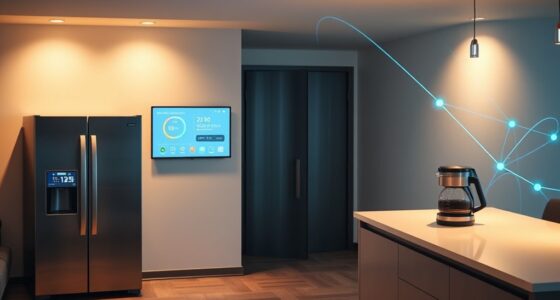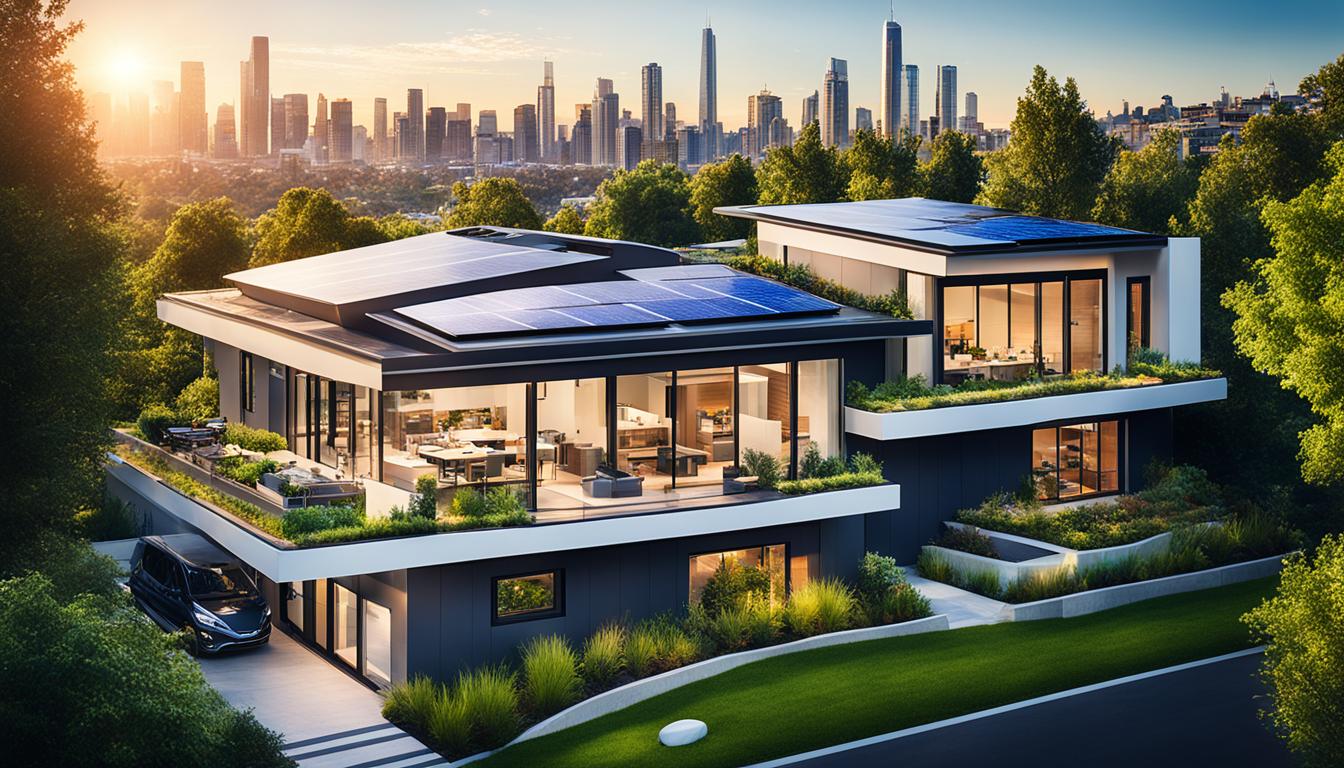OpenADR enables your utility to send automated signals to your home devices, like thermostats or water heaters, to reduce energy use during peak times or emergencies. These signals are securely delivered over your internet connection and interpreted by your smart devices through standardized formats. Your devices respond automatically, adjusting their settings without your intervention. If you want to understand how these signals keep your home energy-efficient and support grid stability, there’s more to explore.
Key Takeaways
- Demand response signals are sent from utilities to your smart home devices via secure internet protocols like HTTPS or XMPP.
- These signals include alerts, load reduction requests, or ramping instructions to adjust energy usage automatically.
- Devices interpret signals using standardized data formats such as XML and predefined rules for response actions.
- Your smart devices, like thermostats or water heaters, automatically respond to signals without needing manual input.
- This process helps lower energy costs, supports grid stability, and ensures efficient, automated load management at home.
Understanding the OpenADR Communication Framework
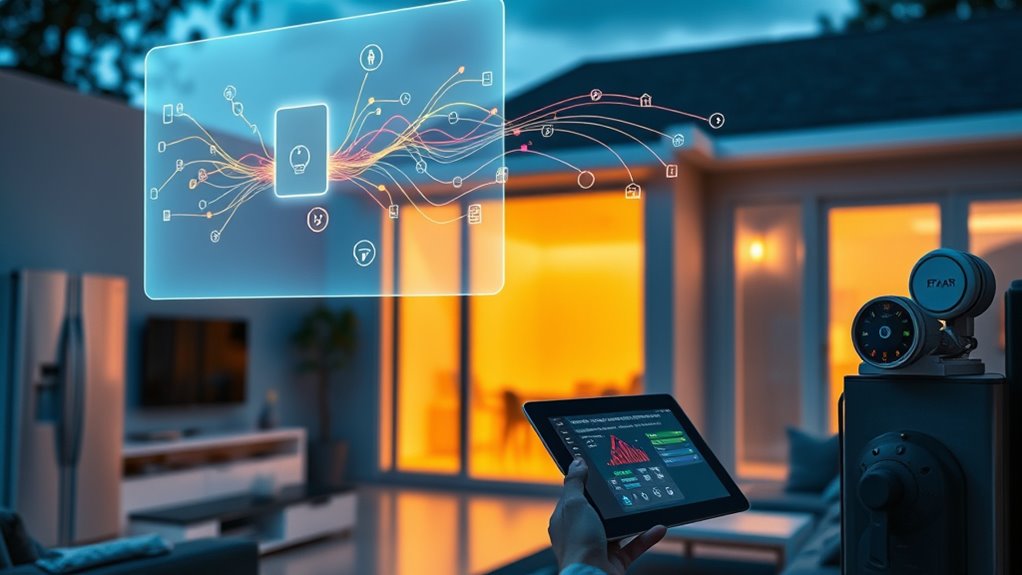
The OpenADR communication framework is designed to enable seamless and secure exchange of demand response signals between utilities and consumers. You’ll find it uses an open standard, making it easy for different devices and systems to work together. It relies on XML for data modeling, supporting messages about pricing, reliability, and activation events. The framework guarantees secure two-way communication with TLS 1.2 and digital certificates, protecting your data’s privacy. Communication flows in a hierarchical setup, with utilities hosting the Virtual Top Node (VTN) and your devices or aggregators acting as Virtual End Nodes (VENs). The system supports various transport protocols like RESTful HTTP, SOAP, and XMPP, ensuring reliable, real-time messaging. This setup helps manage dynamic pricing and emergency demand response events efficiently and securely. Additionally, understanding the security protocols used in OpenADR is crucial for safeguarding your system against potential cyber threats. The framework also emphasizes interoperability, allowing diverse systems to communicate effectively without compatibility issues.
Key Participants: VTN and VEN Explained
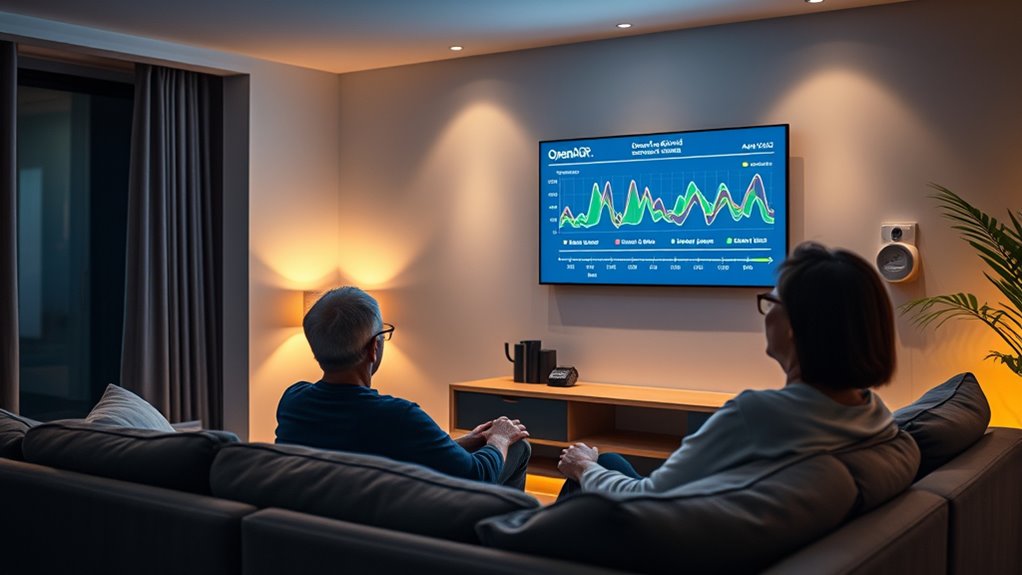
Understanding the roles of VTN and VEN helps you see how demand response works in your home. The VTN acts as the central hub, sending signals to your devices, while the VEN receives those signals and adjusts energy use accordingly. Together, they enable a seamless, automated process to manage your energy consumption efficiently. OpenADR standards ensure that these signals are compatible across different devices and systems, making automation reliable and straightforward. Additionally, communication protocols facilitate secure and effective data exchange between components.
Effective communication depends on established standards, which ensure interoperability among diverse systems and devices.
VTN and VEN Roles
In OpenADR systems, the Virtual Top Node (VTN) and Virtual End Node (VEN) play essential roles in managing demand response (DR) programs. The VTN acts as a resource server, hosting APIs to send DR events and receive reports. It’s typically operated by utilities, system operators, or aggregators, responsible for managing DR signals, defining report requests, and enrolling VENs. The VTN can also operate as a VEN in hierarchical setups. The VEN, on the other hand, is a client application that receives DR events from the VTN and executes actions like adjusting loads. It reports energy usage and status back to the VTN, helping monitor program participation. The technological infrastructure that supports these components ensures secure and reliable communication channels. This infrastructure often incorporates secure communication protocols to protect data integrity and privacy. Together, they create a flexible, secure, and coordinated system for demand response management. Reporting flow can also occur in both directions, allowing for real-time feedback and data exchange between the VTN and VEN to optimize program effectiveness.
Communication Process Flow
Demand response communication flows through a structured exchange between the VTN and VEN, with the VTN initiating signals to manage grid conditions and demand-side responses. The VTN acts as the server, sending event notifications, grid updates, and pricing information via secure XML-based messages. These signals are broadcast to one or more VENs, which serve as clients, often representing individual devices or aggregations. Responses are bidirectional: VENs send feedback, consumption data, and opt-in/out choices back to the VTN. This process enables real-time monitoring and automatic or manual load adjustments. Signals are typically sent ahead of peak periods, giving VENs time to respond. The seamless flow ensures grid stability while offering flexibility for participants to control their participation during demand response events. A clear understanding of Cultural Intelligence can further enhance communication effectiveness and responsiveness in diverse operational environments. Additionally, robust communication protocols are essential to ensure accurate and secure data exchange, minimizing the risk of miscommunication or technical issues.
Types of Demand Response Signals and Their Meanings

| Signal Type | Purpose | Example |
|---|---|---|
| Pending Signal | Pre-event warning | 30 minutes before event |
| Simple Signal | Load shed request | Level 2 (moderate reduction) |
| RampUp/Recovery | Shift period guidance | 15-minute ramping |
How Signals Are Delivered and Interpreted

Signals are sent from the utility’s Virtual Top Node (VTN) to your devices through secure, standardized messages. Your home’s Virtual End Nodes (VENs) poll the VTN regularly to retrieve these signals and interpret them automatically. This process guarantees your devices respond quickly and accurately to demand response events, helping balance the grid efficiently.
Signal Transmission Methods
OpenADR communicates through a client-server architecture where a Virtual Top Node (VTN) at the utility manages the distribution of demand response instructions to Virtual End Nodes (VENs) at customer sites. These signals are transmitted over IP-based networks, including the Internet, using secure web services like RESTful APIs or XML over HTTPS. The signals travel through common communication channels such as Ethernet, Wi-Fi, or cellular networks, guaranteeing broad compatibility. To protect data, encryption methods like SSL/TLS and cryptographic protocols such as ECC or RSA secure the transmission, preventing unauthorized access. VEN devices may use various network interfaces and gateways to receive signals and translate them into actions. Redundant paths and acknowledgments help ensure signals arrive accurately and on time, supporting reliable demand response management. Additionally, signal transmission methods are designed to accommodate various network infrastructures, ensuring consistent communication regardless of the specific technology used.
Signal Interpretation Process
When a demand response instruction reaches your home, your VEN device receives and processes the message to determine the appropriate action. It uses standardized data formats like XML over protocols such as XMPP or HTTP to interpret signals. The VEN, whether a physical device or cloud-based, analyzes the signal, which may include load control, pricing, or energy reduction commands. It then follows predefined rules or strategies to decide how to respond, whether by adjusting your smart appliances, thermostats, or other systems. Some signals are automated, executing actions directly, while others serve as alerts for manual intervention. Throughout this process, the system guarantees secure communication, maintaining your privacy and protecting against unauthorized access. The goal is efficient, reliable energy management aligned with your energy provider’s demand response goals. Additionally, Crochet Styles for Locs can be integrated into home decor or personal accessories, showcasing creative expression. Understanding the demand response signals and their interpretation helps ensure your home responds correctly and efficiently to energy management commands.
Automated Response: Devices That React to Signals

Devices configured as Virtual End Nodes (VENs) automatically respond to demand response events by adjusting their operation without user intervention. When a DR signal arrives, these devices can perform actions like lowering thermostat settings, turning off non-essential loads, or delaying appliance use. Common devices include smart thermostats, water heaters, HVAC systems, EV chargers, and IoT appliances integrated into home energy systems. This automation allows devices to react swiftly to grid conditions, helping reduce peak demand and stabilize the grid. They often use predefined scenes or programs to carry out demand response strategies triggered by price or load reduction signals. Automated responses minimize human error, ensure consistent device behavior, and improve the reliability of demand response efforts without requiring homeowner input. Incorporating demand response signals can further optimize these responses by enabling more precise control based on real-time grid needs. Additionally, device interoperability ensures seamless communication between different smart devices, enhancing overall system responsiveness and efficiency.
Benefits of Using OpenADR for Homeowners

Utilizing OpenADR for demand response offers homeowners tangible benefits that go beyond automated device actions. It helps you save money, increase system compatibility, and support a healthier environment. For example, you can:
- Reduce energy costs during peak pricing events with automatic load adjustments
- Qualify for utility incentives or rebates for installing DR-capable systems
- Enjoy seamless integration with existing home devices, including batteries and EV chargers
- Contribute to a more reliable grid, helping prevent blackouts and reduce infrastructure costs
- Implementing Fokos solutions can further enhance your energy management and provide additional insights into your consumption patterns. Additionally, adopting demand response technology can lead to more efficient energy use and greater cost savings over time.
These advantages make participating in demand response easier, more affordable, and impactful. By leveraging OpenADR, you gain control over your energy consumption, lower expenses, and support a cleaner, more resilient electrical grid—all with minimal effort on your part.
Technical Workflow of Demand Response Signals
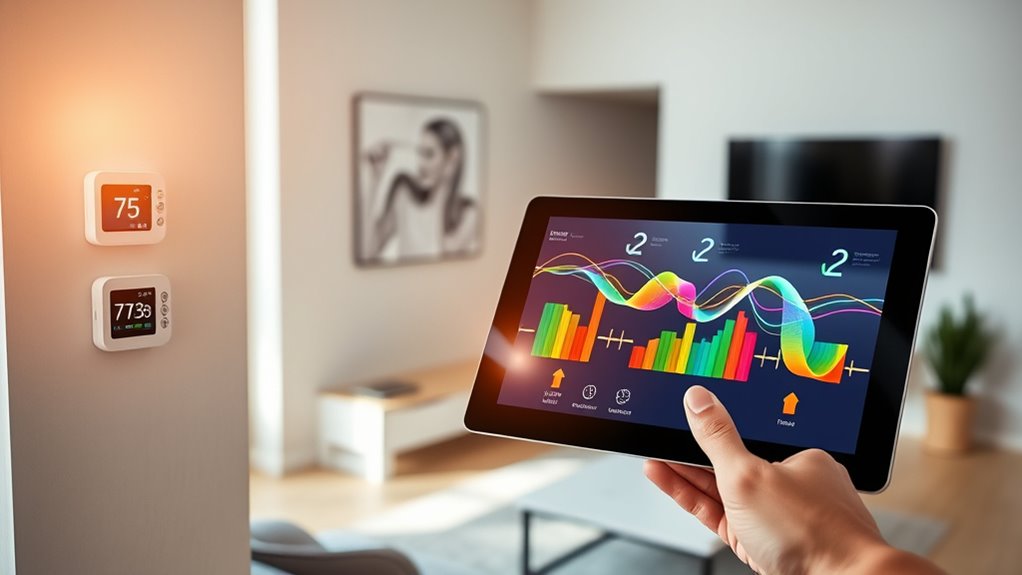
Demand response signals follow a structured workflow that guarantees reliable communication between utility providers and your home systems. The utility initiates DR events through a Virtual Top Node (VTN), which sends signals via standardized OpenADR protocols over the internet—using LAN, WAN, cellular, or Wi-Fi networks. These signals include event notifications that specify load reduction or pricing adjustments. Your Virtual End Node (VEN) receives these signals and responds with opt-in or opt-out messages to confirm participation. The VTN then tracks responses and manages payloads for event initiation, telemetry, and reporting. Once a DR event is active, your pre-programmed control systems automatically adjust loads, like HVAC or lighting, based on the received signals. This seamless process guarantees reliable, automated demand management without manual intervention. Additionally, understanding the health benefits of certain products can help optimize your home’s energy and health environment. Incorporating secure communication protocols can further enhance the reliability and safety of the demand response system.
Future Developments in Demand Response Technology

Advancements in energy storage and grid integration are shaping the future of demand response technology. You’ll see safer, higher-capacity batteries like solid-state models replacing traditional lithium-ion ones, while hydrogen fuel cells emerge for long-term storage. Flow batteries will become more scalable for large-scale demand management, and residential systems will grow, enabling you to shift loads and shave peaks at home. Integration with renewables will increase, giving you more flexibility. Additionally, smart grids and IoT devices will provide real-time, granular control over your energy use. AI and machine learning will optimize demand patterns and forecast needs, making responses faster and more accurate. Utility virtual power plants will combine your distributed energy resources, turning them into powerful grid assets. Dog names can be an inspiration for personalized naming of your smart home devices, making technology feel more friendly and approachable. Moreover, advanced battery technologies will enhance the reliability and capacity of home energy systems, ensuring more efficient demand response capabilities.
Frequently Asked Questions
How Secure Is the Communication Between VTN and VEN Devices?
The communication between VTN and VEN devices is highly secure. You benefit from TLS encryption with digital certificates, ensuring data stays private and tamper-proof. Mutual authentication with certificates prevents unauthorized access. Messages are digitally signed for integrity and non-repudiation, and timestamps help verify freshness. These measures protect against attacks, spoofing, and unauthorized commands, providing a robust security framework proven in global deployments, so your demand response signals stay safe and trustworthy.
Can Homeowners Customize Their Response to Different DR Signals?
Think of your home’s response to DR signals like tuning a musical instrument. You can customize how your devices react to different signals, adjusting settings or thresholds to match your comfort and energy goals. Your OpenADR client device allows you to set preferences, choose manual or automatic responses, and even schedule actions. This way, you control the harmony between energy savings and your household needs, making demand response more tailored and effective.
What Types of Smart Home Devices Are Compatible With Openadr?
You can integrate smart thermostats, HVAC controllers, EV chargers, and energy monitoring devices with OpenADR. These devices respond to demand response signals by adjusting temperature settings, cycling HVAC systems, delaying charging, or managing loads to reduce peak demand. Many are ZigBee-based or compatible with controllers like ISY994, supporting protocols like Z-Wave or dry contacts, making it easy to automate energy savings and grid support in your home.
How Does Openadr Handle Communication Failures or Interruptions?
When communication drops, think of it as a sudden storm cloud blocking your signal sky. OpenADR keeps your DERs running on default or preset settings, like a steady lighthouse guiding ships safely home. It doesn’t disrupt ongoing demand response events but pauses new signals. You can trust your system to revert to safe, reliable operations, ensuring your home stays balanced, even when the digital weather turns stormy.
Are There Privacy Concerns With Sharing Energy Usage Data via Openadr?
Yes, there are privacy concerns when sharing energy usage data via OpenADR. Your sensitive consumption patterns could be exposed or misused if proper safeguards aren’t in place. External parties like utilities or aggregators might access personal habits, risking privacy breaches. To protect yourself, make certain strong cybersecurity measures, transparent data policies, and trusted entities are involved, so your energy data remains confidential and is used only for its intended demand response purposes.
Conclusion
By embracing OpenADR, you’re gently guiding your home’s energy flow, like a calm breeze whispering through the trees. It seamlessly coordinates your devices, creating a harmonious dance that benefits both your comfort and the environment. As technology evolves, this steady rhythm will become even more intuitive, helping you navigate energy savings with ease. Ultimately, OpenADR offers a subtle, yet powerful way to keep your home in tune with the world’s changing energy landscape.


